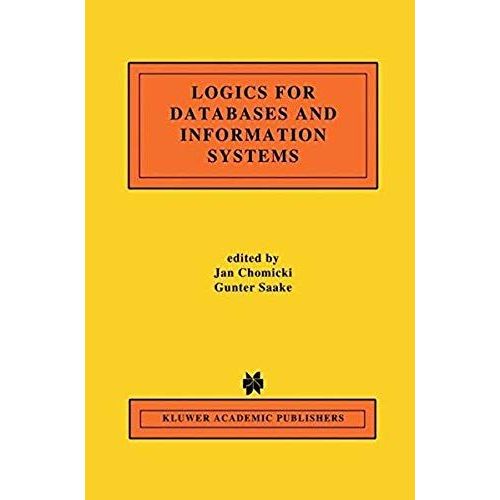

Logics for Databases and Information Systems -
- Format: Broché
- 448 pages Voir le descriptif
Vous en avez un à vendre ?
Vendez-le-vôtre304,63 €
Produit Neuf
Ou 76,16 € /mois
- Livraison : 25,00 €
- Livré entre le 8 et le 13 août
- Payez directement sur Rakuten (CB, PayPal, 4xCB...)
- Récupérez le produit directement chez le vendeur
- Rakuten vous rembourse en cas de problème
Gratuit et sans engagement
Félicitations !
Nous sommes heureux de vous compter parmi nos membres du Club Rakuten !
TROUVER UN MAGASIN
Retour

Avis sur Logics For Databases And Information Systems Format Broché - Livre Littérature Générale
0 avis sur Logics For Databases And Information Systems Format Broché - Livre Littérature Générale
Donnez votre avis et cumulez 5
Les avis publiés font l'objet d'un contrôle automatisé de Rakuten.
-

Codex Seraphinianus
Occasion dès 280,00 €
-

Zohar - The Complete Original Aramaic Text
Neuf dès 231,99 €
Occasion dès 190,00 €
-

The Vocabulary Guide Anglais - Les Mots Anglais Et Leur Emploi
6 avis
Occasion dès 199,00 €
-

Moebius Visioni Di Fine Millennio
Occasion dès 210,00 €
-

The World Of Ornament
Occasion dès 229,99 €
-

A.I Artificial Intelligence, From Stanley Kubrick To Steven Spielberg : The Visions Behind The Film
1 avis
Occasion dès 266,00 €
-

Warhammer Armies Skaven (French Edition)
2 avis
Occasion dès 250,00 €
-

Maison Martin Margiela : Street Special Edition Volumes 1 & 2
Occasion dès 190,00 €
-

Cipullo: The Man Who Made Jewelry Modern
Neuf dès 195,00 €
-

New York State Of Mind
Occasion dès 193,88 €
-

Antique Glass Bottles Their History And Evolution (1500-1850)
Occasion dès 152,99 €
-

Exhibit A: Guy Bourdin
1 avis
Occasion dès 189,99 €
-

Livre D'évaluation Clinique: Un Guide D'évaluation Clinique Orthopédique
Occasion dès 175,99 €
-

Handbook Of The Birds Of The World-Volume 8 , Broadbills To Tapaculos
Occasion dès 188,99 €
-

Atlas Of Small Animal Ultrasonography
Neuf dès 243,97 €
-

Modernist Pizza. Englische Ausgabe
Neuf dès 375,00 €
Occasion dès 353,57 €
-

Erwin Olaf: Volume Ii
Occasion dès 198,50 €
-

Marvel Comics Library. Avengers. Vol. 1. 1963-1965
1 avis
Neuf dès 175,00 €
Occasion dès 172,01 €
-

Sekiro Shadows Die Twice, Official Game Guide
1 avis
Occasion dès 158,79 €
-

David Lynch
Occasion dès 366,99 €
Produits similaires
Présentation Logics For Databases And Information Systems Format Broché
- Livre Littérature GénéraleEditeur : Springer Us, New York, N.Y.Langue : AnglaisParution : 01/10/2012Format : Moyen, de 350g à 1kgNombre de pages : 448Expédition : 674Dimensions : 23.5 x 15.5 x 2.5 ...

Résumé :
The designers and users of present-day information systems deal with more and more complex applications that have to meet stringent quality requirements. In this context, logic offers a wide variety of formalisms that can be applied to the specification, analysis, and prototype implementation of information systems. Such formalisms, e.g., temporal logic, provide a sound semantic basis for further extensions and for the development of practical database languages. br/ emLogics for Databases and Information Systems/em addresses novel applications of logical frameworks to the problems of database integrity and dynamics, handling time and change, concurrency, incomplete information, data modeling, and property inheritance. Each topic is discussed by leading researchers in the field. br/ emLogics for Databases and Information Systems/em is suitable as a secondary text for a graduate level course on Databases and Information Systems, and as a reference for researchers and practitioners in industry.
Sommaire:
1 Introduction to Logics for Databases and Information Systems.- References.- 2 A Logic Primer.- 2.1 Introduction.- 2.2 First-Order Logic (FOL).- 2.3 Modal Logics.- 2.4 Logic Programming.- 2.5 Conclusion.- References.- 3 Temporal Logic in Information Systems.- 3.1 Introduction.- 3.2 Temporal Databases.- 3.3 Temporal Queries.- 3.4 Temporal Integrity Constraints.- 3.5 Multidimensional Time.- 3.6 Beyond First-order Temporal Logic.- 3.7 Conclusions.- References.- 4 The Role of Deontic Logic in the Specification of Information Systems.- 4.1 Introduction: Soft Constraints and Deontic Logic.- 4.2 Standard Deontic Logic (SDL).- 4.3 The Paradoxes of Deontic Logic.- 4.4 A Diagnosis of the Problems.- 4.5 A Solution to the 'Ought-to-Be' Version of the Chisholm Paradox: S5O(n).- 4.6 Ought-to-Do: The Dynamic Perspective.- 4.7 An Integrated Logic of Ought-to-Be and Ought-to-Do Constraints.- 4.8 Applications.- References.- 5 A Logic for Programming Database Transactions.- 5.1 Introduction.- 5.2 Overview and Introductory Examples.- 5.3 Syntax.- 5.4 Elementary Operations.- 5.5 Model Theory.- 5.6 Proof Theory.- 5.7 Related Work.- References.- 6 Logics for Specifying Concurrent Information Systems.- 6.1 Introduction.- 6.2 Overview.- 6.3 Local Logic L.- 6.4 Distributed Logics.- 6.5 Reduction.- 6.6 Extended Example.- 6.7 Related Work.- 6.8 Concluding Remarks.- References.- 7 Evolving Logical Specification in Information Systems.- 7.1 Introduction.- 7.2 Motivation and Language.- 7.3 Syntax and Semantics of the Logic.- 7.4 Translation of Language into Logic.- 7.5 Using the Logical Framework.- 7.6 Concluding Remarks.- References.- 8 Description Logics for Conceptual Data Modeling.- 8.1 Introduction.- 8.2 Description Logics.- 8.3 Semantic Data Models.- 8.4 Object-Oriented Data Models.- 8.5Support for Data Modeling.- 8.6 Conclusions.- References.- 9 Integrity Constraints: Semantics and Applications.- 9.1 Introduction.- 9.2 Background.- 9.3 Semantics of Integrity Constraints.- 9.4 Reasoning with Integrity Constraints.- 9.5 Applications of Integrity Constraints.- 9.6 Conclusion and Future Directions.- References.- 10 Logical Approaches to Incomplete Information: A Survey.- 10.1 Introduction.- 10.2 Sources of Indefiniteness.- 10.3 A Semantic Framework for Incomplete Databases.- 10.4 Algebraic Models of Nulls.- 10.5 Logical Databases.- 10.6 Complexity of Queries.- 10.7 Negative Information.- 10.8 Integrity Constraints.- 10.9 Updates of Incomplete Databases.- 10.10 Other Issues.- 10.11 Incomplete Information in Current Technology.- References.- 11 Declarative Frameworks for Inheritance.- 11.1 Introduction.- 11.2 Motivation for Inheritance.- 11.3 Main Issues and Problems.- 11.4 Logic-based Approaches to Inheritance.- 11.5 Research Directions.- References.- 12 On Logical Foundations of Active Databases.- 12.1 Introduction.- 12.2 Basics of Active Rules.- 12.3 Research on Foundations of Active Rules.- 12.4 A Deductive State-Oriented Core Language.- 12.5 A Framework for Active Rules.- 12.6 Conclusion.- References.
Détails de conformité du produit
Personne responsable dans l'UE
